For economies with a high degree of capital mobility, there are essentially four different sets of policy-mix alternatives that can provoke a reaction in FX markets following an economic or geopolitical shock:
-
Scenario 1: Fiscal policy is already expansionary + monetary policy becomes more restrictive (“tightening”) = Bullish for the local currency
-
Scenario 2: Fiscal policy is already restrictive + monetary policy becomes more expansionary (“loosening”) = Bearish for the local currency
-
Scenario 3: Monetary policy already expansionary (“loosening”) + fiscal policy becomes more restrictive = Bearish for the local currency
-
Scenario 4: Monetary policy is already restrictive (“tightening”) + fiscal policy becomes more expansionary = Bullish for the local currency
It is important to note that for an economy like the United States and a currency like the US Dollar, whenever fiscal policy and monetary policy start trending in the same direction, there is often an ambiguous impact on the currency. Below we will examine how various fiscal and monetary policy remedies for geopolitical and economic shocks impact currency markets.
SCENARIO 1 – FISCAL POLICY LOOSE; MONETARY POLICY BECOMES TIGHTER
On May 2, 2019 – following the FOMC decision to hold rates in the 2.25-2.50 percent range – Fed Chair Jerome Powell said that relatively soft inflationary pressure noted at the time was “transitory”. The implication here was that while price growth was below what central bank officials were hoping for, it would soon accelerate.The US-China trade war played a role in slowing economic activity and muting inflation.
The implicit message was then a reduced probability of a rate cut in the near term, given that the fundamental outlook was judged to be solid and the overall trajectory of US economic activity seen to be on a healthy path. The neutral tone struck by the Fed was comparatively less dovish than what markets had anticipated. This might then explain why the priced-in probability of a Fed rate cut by the end of the year (as seen in overnight index swaps) fell from 67.2 percent to 50.9 percent after Powells comments.
Meanwhile, the Congressional Budget Office (CBO) forecasted an increase in the fiscal deficit over a three-year time horizon, overlapping the central bank‘s would-be tightening cycle. What’s more, this came against the backdrop of speculation about a bipartisan fiscal stimulus plan. In late April, key policymakers announced plans for a US$2 trillion infrastructure building program.
The combination of expansionary fiscal policy and monetary tightening made the case for a bullish US Dollaroutlook. The fiscal package was expected to create jobs and boost inflation, thereby nudging the Fed to raise rates. As it happened, the Greenback added 6.2 percent against an average of its major currency counterparts over the subsequent four months.
Scenario 1: DXY, 10-Year Bond Yields Rise, S&P500 Futures Fall
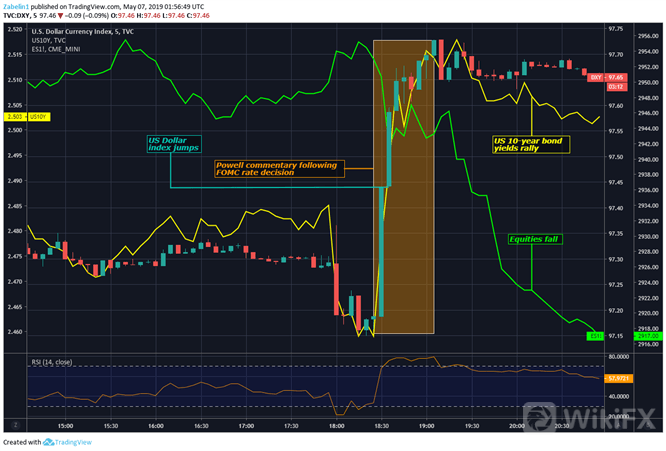
SCENARIO 2 – FISCAL POLICY TIGHT; MONETARY POLICY BECOMES LOOSER
Theglobal financial crisis in 2008 and the Great Recession that followed rippled out worldwide and destabilized Mediterranean economies. This stoked worries about a region-wide sovereign debt crisis as bond yields in Italy, Spain and Greece climbed to alarming levels. Mandated austerity measures were imposed in some cases which helped create the basis for Eurosceptic populism that hence haunted the region.
Investors began to lose confidence in the ability of these governments to service their debt and demanded a higher yield for incurring what appeared to be a rising risk of default. The Euro was in pain amid the chaos as doubtsemerged about its very existence in the event that the crisis forced the unprecedented departure of a member state from the Eurozone.
In what is considered to be one of the most famous moments in financial history, European Central Bank (ECB) President Mario Draghi delivered a speech in London on July 26, 2012 which many would come to see as a pivotal moment that saved the single currency. He said that the ECB is “ready to do whatever it takes to preserve the Euro. And believe me,” he added,“it will be enough.” This speech calmed European bond markets and helped bring yields back down.
The ECB alsocreated a bond-buying program called OMT (for “Outright Monetary Transactions”). It was aimed at reducing stress in sovereign debt markets, offering relief to distressed Eurozone governments. While OMT was never used, its mere availability helped becalm jittery investors.At the same time, many of the troubled Euro area states adopted austerity measures to stabilize government finances.
While the Euro initially rose as worries about its collapse receded, the currency would depreciate substantially against the US Dollar over the course of the following three years. By March 2015, it had lost over 13 percent of its value. When examining the monetary and fiscal set up, it becomes quite clear why.
Scenario 2: Euro Sighs Relief – Sovereign Bond Yields Fall as Insolvency Fears are Quelled
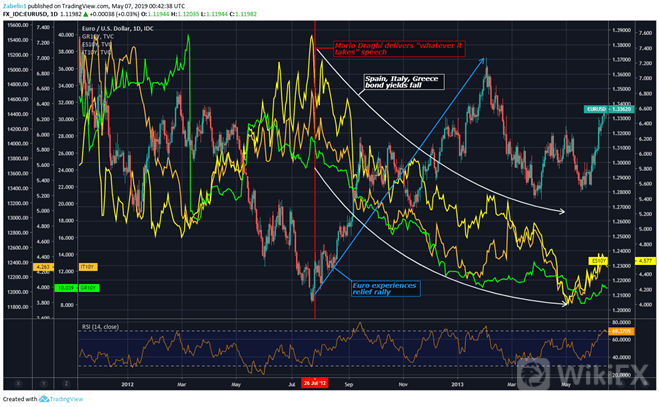
Austerity measures in many Eurozone countries limited their governments ability to provide fiscal stimulus that might have helped create jobs and boost inflation. At the same time, the central bank was easing policy as a way to alleviate the crisis. Consequently, this combination pressured the Euro lower against most of its major counterparts.
Scenario 2: Euro, Sovereign Bond Yields Fall
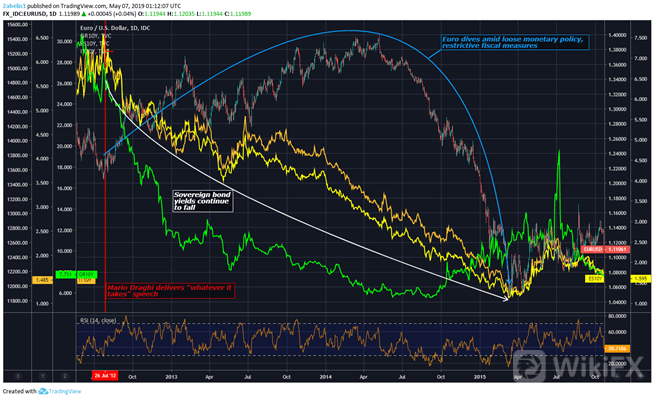
SCENARIO 3 – MONETARY POLICY LOOSE; FISCAL POLICY BECOMES TIGHTER
At the early stages of the Great Recession, the Bank of Canada (BOC) cut its benchmark interest rate from 1.50 to 0.25 percent as a way to ease credit conditions, restore confidence and revive economic growth. Counterintuitively, the yield on 10-year Canadian government bonds began to rise. This rally came right around the same time as Canadas benchmark TSX stock index established a bottom.
Scenario 3: USD/CAD, TSX, Canadian 2-Year Bond Yields
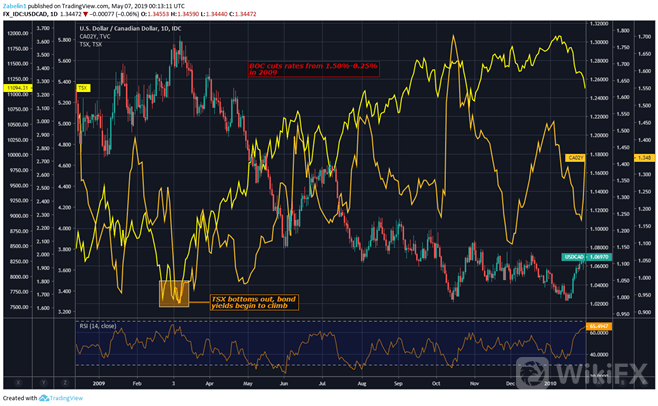
The subsequent restoration of confidence and recovery in share prices was reflected ininvestors‘ shifting preference for riskier, higher-returning investments (like stocks)in lieu of comparatively safer alternatives (like bonds). This reallocation of capital sent yields higher despite the central bank’s monetary easing. The BOC then began to raise its policy interest rate anew and brought it up to 1percent, where it remained for the subsequent five years.
During this time, Prime Minister Stephen Harper implemented austerity measures to stabilize the governments finances amid the global financial crisis. The central bank then reversed course and cut rates back to 0.50 percent by July 2015.
Both CAD and local bond yields suffered as monetary policy was loosened while the capacity for fiscal policy support was constrained. As it happens, cutting back government spending at this difficult time ended up costing Mr Harper his job. Justin Trudeau replaced him as Prime Minister following a victory in the 2015 general election.
Scenario 3: USD/CAD, Canada 2-Year Bond Yields
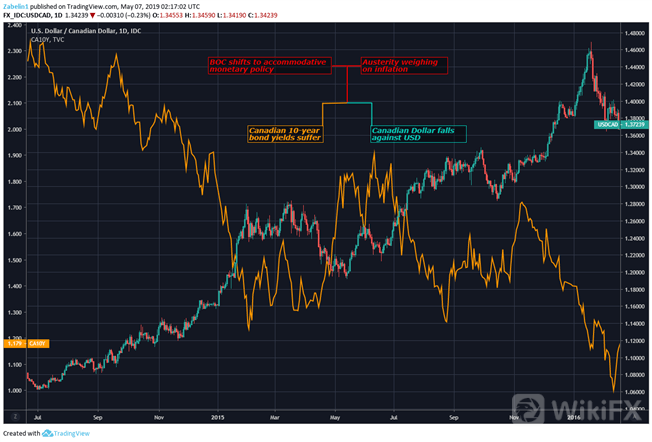
SCENARIO 4 – MONETARY POLICY TIGHT; FISCAL POLICY BECOMES LOOSER
After Donald Trump was proclaimed the victor in the 2016 USpresidential election, the political landscape and economic backdrop favored a bullish outlook for the US Dollar. With the the Oval Office and both houses of Congress thus controlled by the Republican Party, the markets appeared to conclude that scope for political volatility had been reduced.
This made the market-friendly fiscal measures proposed by candidate Trump during the electionappear more likely to be implemented. These included tax cuts, deregulation and infrastructure building. Investors appeared to overlook threats to launch trade wars against top trading partners such as China and the Eurozone, at least for the time. On the monetary side, central bank officials raised rates at the tail end of 2016 and were looking to hike again by at least 75 basis points through 2017.
With scope for fiscal expansion and monetary tightening in sight, the US Dollar rallied alongside local bond yields and equities. This came as corporate earnings expectations strengthened alongside the outlook for broader economic performance. This stoked bets on firmer inflation and thereby on a hawkish response from the central bank.
Scenario 4) US Dollar Index (DXY), S&P 500 Futures, 10-Year Bond Yields (Chart 7)
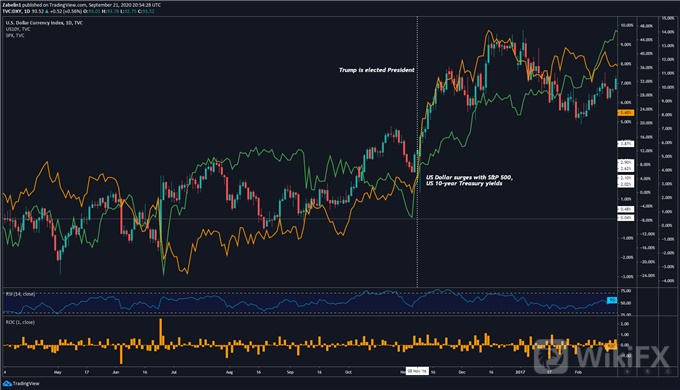
WHY POLITICAL RISKS MATTER FOR TRADING
Countless studies have shown that a significant decline in living standards from war or a severe recession increase the propensity for voters to take up radical positions on the political spectrum. As such, people are more likely to deviate from market-friendly policies – such as capital integration and trade liberalization – and instead focus on measures that turn away from globalization and are deleteriously inward-facing.
The modern globalized economy is interconnected both politically and economically and therefore any systemic shock has a high probability of echoing out into the world. During times of significant political volatility amid inter-continental ideological changes, it is crucial to monitor these developments because within them are opportunities to set up short, medium and long-term trading strategies.
Leave a Reply